Road Salt Impact Study: Bioretention Plants Prove Resilient and Unimpaired by Road Salt Exposure
The salt used to de-ice our roads does not reduce the effectiveness of the plants used in bioretention areas, according to a new study by Henry Beral, a Ph.D. student at UdeM.
Increasing numbers of municipalities across Quebec are building bioretention areas to manage storm runoff. These areas serve two important functions. First, they reduce concentrations of contaminants and harmful organic compounds by harnessing the natural filtering properties of plants and soil microorganisms. Second, they help flatten runoff peaks by absorbing water and routing excess flow to municipal drainage systems.
One contaminant that enters bioretention areas in high concentrations every spring is road salt. But does this salt impair the ability of the plants used in bioretention areas to filter contaminants and absorb water?
Henry Beral, a Ph.D. student supervised by Université de Montréal professors Jacques Brisson and Danielle Dagenais, decided to find out. The results of his experimental study were published in the journal Blue-Green Systems in May 2023.
Simulating spring runoff in mesocosms

Beral conducted his experiment from June 2018 to June 2019 in a greenhouse at UdeM’s Institut de recherche en biologie végétale, on the site of the Montreal Botanical Garden. He created 20 mesocosms—mid-sized containers in which he simulated the effects of spring runoff on bioretention areas. The mesocosms were closed systems whose environmental parameters could be tightly controlled to replicate a natural ecosystem.
For his experiment, Beral selected four plant species commonly used in bioretention areas. Three were native species: red osier dogwood (Cornus sericea), soft rush (Joncus effusus) and blue flag (Iris versicolor). The fourth was autumn moor grass (Sesleria autumnalis), a non-native species.
To simulate spring runoff, Beral introduced salt (NaCl) into the mesocosms when the plants were dormant. He tested three different concentrations of salt and compared them with the control mesocosms, which did not receive salt.
Beral then monitored plant growth and health status at various stages to assess photosynthetic efficiency, CO2 uptake and chlorophyl levels. He also measured changes in water quality and concentrations of salt and other contaminants.
Good absorption of contaminants

Of the four plant species tested, only the non-native autumn moor grass (Sesleria autumnalis) did not survive.
By contrast, none of the three native species was affected by the presence of salt at concentrations similar to those found in spring runoff from Quebec roads. They also absorbed more than 37 per cent of the macronutrients—including nitrogen, phosphorus and potassium—introduced into the mesocosms, enabling them to filter the contaminants from the runoff simulations.
The plants even showed a transient increase in the filtering of heavy metals, such as chromium, copper, nickel and lead. The high salt concentrations triggered the release of calcium from the soil, which in turn facilitated heavy-metal absorption.
Beral’s lab findings were confirmed by tests carried out on bioretention areas in Montreal and Trois-Rivières.
“Our results indicate that de-icing salt does not impair the resilience of these three native plant species or reduce their ability to absorb contaminants,” said Beral. “This is probably because the spring runoff period is very short and the plants are still in their dormancy period.”
He also pointed to studies showing that bioretention areas reduce heavy metal concentrations in storm runoff by 80 to 100 per cent during the spring, summer and fall.
“These results show that municipalities could benefit from installing even more bioretention areas,” concluded Beral. “These plants really get the job done!”

